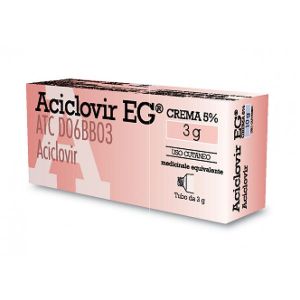Ship in Europe, Find out rates!
Aciclovir Eg 5% Cream Against Herpes Tube 3g

- box Delivery in Italy in 24/48 and free returns
- star3.000+ positive reviews
- dropboxOver 60,000 products in the catalog
Therapeutic indications
ACICLOVIR EG cream is indicated for the treatment of Herpes Simplex skin infections such as: primary or recurrent Herpes genitalis and Herpes labialis.
Dosage
ACICLOVIR EG CREAM should be applied 5 times a day at intervals of approximately 4 hours. ACICLOVIR EG cream should be applied to the lesions, or the areas where they are developing, as soon as possible, preferably during the earliest stages (prodrome or erythema). Treatment can also be started during the later stages (papules or vesicles). Treatment should continue for at least 4 days for herpes labialis and for 5 days for herpes genitalis. If there is no healing, treatment can continue for up to 10 days.
Overdose
Even if the entire contents of a 10g cream tube containing 500mg of acyclovir are ingested, no side effects should be expected.
Contraindications
ACICLOVIR EG cream is contraindicated in patients with known hypersensitivity to aciclovir, valaciclovir, propylene glycol or any of the other ingredients of ACICLOVIR EG cream.
Side effects
The following convention has been used for the classification of undesirable effects in terms of frequency: very common ≥ 1/10, common ≥ 1/100 and <1/10, uncommon ≥ 1 / 1,000 and <1/100, rare ≥ 1 /10,000 and <1 / 1,000, very rare <1 / 10,000. Data from these clinical studies were used to assign frequency categories to adverse reactions observed during clinical trials on the use of aciclovir cream. Due to the nature of the adverse events observed, it is not possible to uniquely determine which events are related to drug administration and which are related to the disease itself. Data from spontaneous reporting was used as a basis for determining the frequency of those events detected by post-marketing pharmacovigilance. Skin and subcutaneous tissue disorders Uncommon: Transient burning or pain after application of aciclovir cream. Moderate dryness and peeling of the skin. Pruritus Rare: Erythema. Contact dermatitis after application. Where susceptibility tests were conducted, it was shown that the substances that gave phenomena of reactivity were the components of the base cream rather than acyclovir. Immune system disorders Very rare: immediate hypersensitivity reactions including angioedema and urticaria. Reporting of suspected adverse reactions Reporting suspected adverse reactions that occur after authorization of the medicinal product is important, as it allows continuous monitoring of the benefit / risk ratio of the medicinal product. Healthcare professionals are asked to report any suspected adverse reactions via the national reporting system at www.agenziafarmaco.gov.it/it/responsabili.
Pregnancy and breastfeeding
Fertility See Clinical Studies in section 5.2. Pregnancy The use of aciclovir should only be considered if the potential benefits outweigh the possibility of unknown risks, however, the systemic exposure to aciclovir following topical application of aciclovir cream is very low. A registry of post-marketing use of aciclovir in pregnancy provided data on pregnancy outcomes in women exposed to the various aciclovir formulations. These observations did not show an increase in the number of birth defects among acyclovir exposed subjects compared to the general population, and all birth defects found did not show any particularities or common characteristics that would suggest a single cause. systemic of aciclovir in internationally accepted standard tests, did not produce embryonic toxicity or teratogenic effects in rabbits, rats or mice. In an experimental test in rats not included in the classic teratogenic tests, abnormalities of the fetus were observed after subcutaneous doses of aciclovir so high as to produce toxic effects in the mother. However, the clinical relevance of these findings is uncertain. Lactation Limited data indicate that the drug is found in breast milk following systemic administration. However, the dose received by an infant following the use of aciclovir cream in the mother should be insignificant.
Special warnings
Aciclovir cream is not recommended for ophthalmic use, it is recommended to apply it to the mucous membranes of the mouth or vagina as it may be irritating. Particular care should be taken to avoid accidental application into the eye. Animal studies indicate that applying ACICLOVIR EG cream into the vagina may cause reversible irritation. In severely immunocompromised patients (AIDS patients or bone marrow transplant patients) administration of aciclovir in oral formulations should be considered. Such patients should be recommended to consult their physician regarding the treatment of any infection. The excipient propylene glycol can cause skin irritation and the excipient cetostearyl alcohol can cause local skin reactions (e.g. contact dermatitis). The use of the product, especially if prolonged, can give rise to sensitization phenomena, where this happens it is necessary to stop the treatment and consult the attending physician. There are no reports of addiction or dependence on the drug.
Expiry and Retention
Store at a temperature not exceeding 25 ° C.
Active principles
1 g of cream contains : Active substance aciclovir 50 mg For a full list of excipients, see section 6.1.
Excipients
Poloxamer 407 Cetostearyl alcohol Sodium laurilsulfate White petroleum jelly Liquid paraffin Sucrose monopalmitate Propylene glycol Purified water

